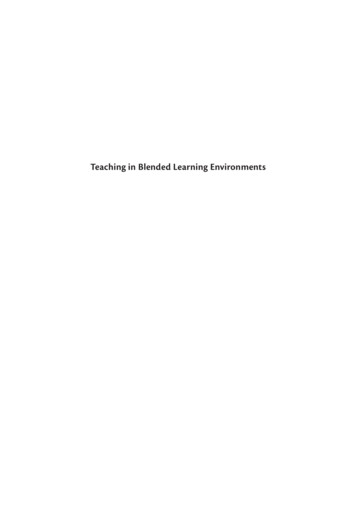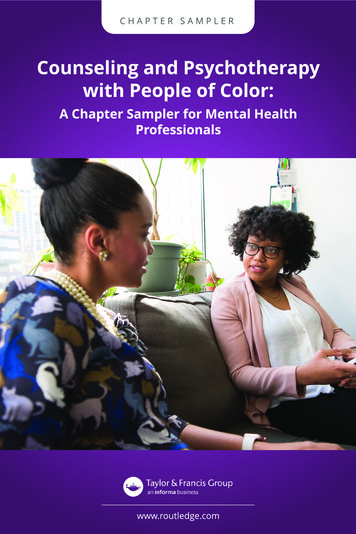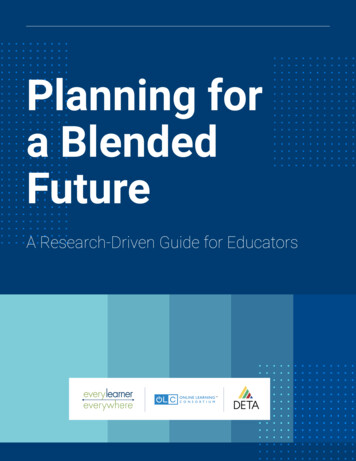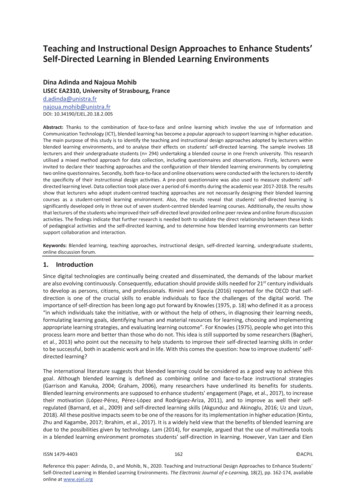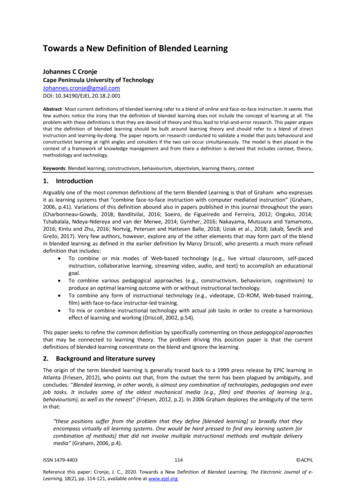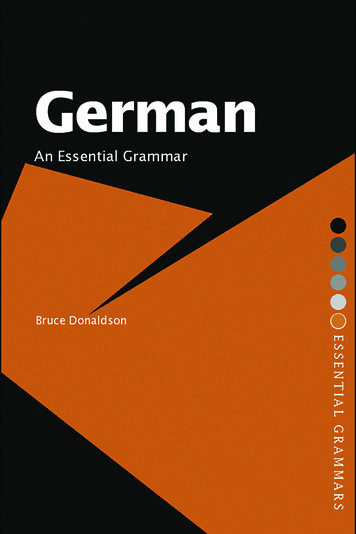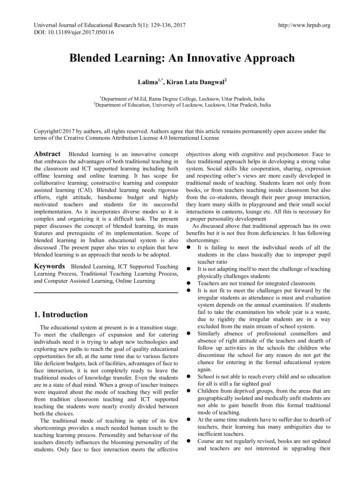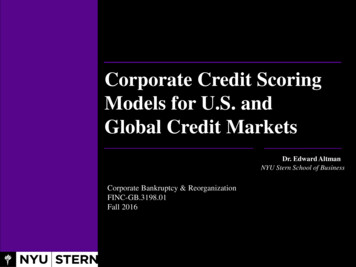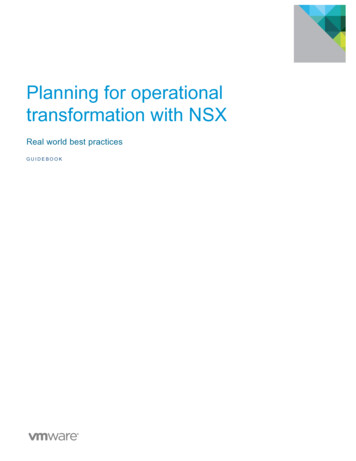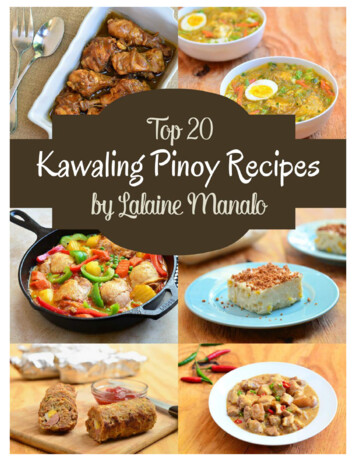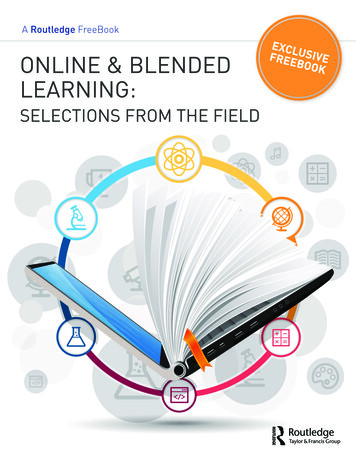
Transcription
A Routledge FreeBookONLINE & BLENDEDLEARNING:SELECTIONS FROM THE FIELDEXCLFREE USIVEBOOK
TABLEOFCONTENTS003 FOREWORD006 1: ORIENTATION TO BLENDEDTEACHING AND LEARNING022 2: WHAT YOU CAN DO ONLINE, BUT NOT ON CAMPUS034 3: BUILDING A SOLID FOUNDATION061 4: PREPARING STUDENTS FOR ONLINE LEARNING076 5: PRINCIPLES FOR DATA ANALYSIS IN ONLINEAND BLENDED LEARNING RESEARCH092 6: SCALING BLENDED LEARNING EVALUATIONBEYOND THE UNIVERSITY111 7: THE SECOND WAVE: BLENDING INTO THEMAINSTREAM (EARLY 2000s)
FOREWORDNow in its twenty-second year of publication, Online Learning (OLJ) continues toprovide scholars, practitioners, administrators, students, and policy makers withrigorous, peer reviewed research in the field. Published quarterly, “the journalpromotes the development and dissemination of new knowledge at the intersectionof pedagogy, emerging technology, policy and practice in online environments.”(Online Learning Consortium, 2016). Oftentimes the publication schedule includesspecial issues that focus on pertinent topics in the field such as learning analytics,accessibility, and k-12 online learning, along with the annual conference editionwhich features papers from selected presentations at OLC conferences over thecourse of the given year. More recently, Online Learning has partnered with theAmerican Education Research Association’s (AERA) Special Interest Group, OnlineTeaching & Learning, to publish a special issue that features the top SIG paperspresented at the annual AERA conference.In the past five years, the journal has undergone a name change (formerly the Journalof Asynchronous Learning Networks), a merger with the Journal for Online Learning andTeaching (JOLT), the flagship publication of the Multimedia Educational Resource forLearning and Online Teaching (MERLOT), and an expansion of the editorial board,including editor-in-chief Dr. Peter Shea, who continues to act in this role. Othermembers of the editorial board have a broad range of expertise in online, blended,and digital education which brings me to the focus of this eBook. Many of the OnlineLearning editorial board members are Routledge authors and, when we look at ourgreat Online Learning Consortium (OLC) community of members, volunteers, andfriends, we have additional Routledge authors in common. This eBook is a collectionof the work of Online Learning editorial board members and OLC communitymembers sourced from recent Routledge book publications.Charles R. Graham, Professor at Brigham Young University, is an Online Learningassociate editor. He is a co-author of Essentials of Blended Learning: A StandardsBased Guide (2014) and Conducting Research in Online and Blended Environments(2015). In Essentials of Blended Learning, Graham and his co-author, Jared Stein,provide practice advice for teaching in the blended learning environment. This eBookfeatures “Chapter 1: Orientation to Online Learning,” in which Graham and Steinprovide an overview of blended learning including definitions, a rationale for blending,course design, and integration of technologies, among other topics.In Conducting Research in Online Learning and Blended Learning Environments (2015),Charles D. Dziuban is joined by co-authors Anthony G. Picciano, Charles R. GrahamROUTLEDGE3ROUTLEDGE.COM
FOREWORDand Patsy D. Moskal. Dziuban and Moskal are long time colleagues at the ResearchInitiative for Teaching Effectiveness at the University of Central Florida and longtimesupporters of OLC; Moskal also serves as a guest Online Learning editor. Picciano isProfessor at CUNY and Hunter College as well as OLC Board Member and OnlineLearning associate editor. The book provides in-depth information on how to planresearch inquiries into online and blended learning. For this eBook, we selectedDziuban’s “Chapter 6: Principles for Data Analysis in Online and Blended LearningResearch.”. In this chapter, the author describes data analysis techniques including aself-analysis rubric, computing resources, and discussions surrounding variablesand statistical significance.Robert Ubell, Vice Dean Emeritus at New York University’s NYU Tandon School ofEngineering, is a member of the Online Learning editorial advisory board as well asformer OLC Board Member. In his recent book, Going Online: Perspectives on DigitalLearning (2017), Dr. Ubell explores the world of virtual education with many wellknown experts in the field. We chose “Chapter 4: What You Can Do Online, But Not OnCampus” as the featured selection for this eBook. Ubell explores digital pedagogicalstrategies that are found online but not in the classroom, including the benefits ofanonymity, learning analytics, writing, and reflection.Now in its fourth edition, Teaching Online: A Practical Guide (2017) is a comprehensiveguide for online teaching. Author Susan Ko, Director of Faculty Development at NYUSchool of Professional Studies, is a longtime OLC supporter and contributor to the digitallearning field. This eBook features “Chapter 10: Preparing Students for Online Learning,”which Ko wrote with co-author Steve Rossen. The chapter delves into the student side ofonline learning, including the perils and pitfalls that students encounter, many of whichfaculty can easily assist with given knowledge of these problems.Michelle Pacanksy-Brock, Faculty Mentor, Digital Innovation at California CommunityColleges, is the author of Best Practices for Teaching with Emerging Technologies(2017), now in its second edition. In this book, Pacansky-Brock explores theapplicability of social media and Web 2.0 tools in learning environments. In “Chapter1: Building A Solid Foundation,” Pacansky-Brock discusses setting expectations forthe use of emerging technologies, building a community, and empowering students,among other topics.In Blinded Learning: Research Perspectives, Volume 2 (2014), Patsy D. Moskal andher co-author Thomas B. Cavanaugh, Vice Provost for Digital learning at University ofCentral Florida, contribute “Chapter 3: Scaling Blended Learning Evaluation BeyondROUTLEDGE4ROUTLEDGE.COM
FOREWORDthe University.” In addition to Moskal’s work for OLC, Cavanaugh is an avid supporterof the organization. Their chapter focuses on the university’s involvement in the NextGeneration Learning Challenges (NGLC) program, a collaborative program focusedon the unique needs of the adult learner in postsecondary education.While Anthony G. Picciano has contributed to many Routledge books, he has authoredseveral of his own. His most recent, Online Education Policy and Practice: The Past,Present, and Future of the Digital University (2017), includes “Chapter 5: The FirstWave: The Past, Present, and Future of the Digital University.” This chapter covers theadvent of the Internet and its expansion, the Alfred P. Sloan Anytime, AnyplaceLearning Program, as well as new financial and pedagogical models for institutions,among other topics.We hope you find this collection of chapters from Routledge authors, all of themcommitted to the Online Learning Journal and the Online Learning Consortium, to athought-provoking entry point into online and blended learning.Dr. Jill BubanSr. Director, Research & InnovationOnline Learning ConsortiumROUTLEDGE5ROUTLEDGE.COM
1C H A P TE RORIENTATION TOBLENDED TEACHINGAND LEARNINGThis chapter is excerpted fromEssentials for Blended Learning: A Standards Based GuideBy Jared Stein and Charles R. Graham 2014 Taylor & Francis Group. All rights reserved.LEARN MORE
CHAPTER 1ORIENTATION TO BLENDEDTEACHING AND LEARNINGExcerpted from Essentials for Blended Learning: A Standards Based GuideImmediate access to people and information through technology is increasing, andthis is transforming our everyday lives. Using connected mobile tools such assmartphones, tablets, and laptops, we purposefully “blend” physical and onlineactivities to create optimal experiences. This is what blended education is all about:situating learning experiences online or onsite based on the relative strengths andweaknesses of each mode.Blended courses provide the opportunity for teachers to mix the best of onsite andonline to create a new learning environment for their students. Research suggeststhat blended courses can have a positive impact on efficiency, convenience, andlearning outcomes. By moving more of the learning to online environments, blendedcourses add flexibility to participants’ schedules, provide learning benefit throughautomated and asynchronous online tools, and can tap into the modern, social Webto help learners venture beyond the traditional confines of the classroom.To consistently achieve such benefits, teachers need to go beyond a simple “digitalfacelift.” Instead, teachers should aim to create transformative blends through anintentional course redesign process.1.1 CHANGING WORLD, CHANGING LEARNERSDavid Wiley, Professor of Instructional Psychology and Technology at Brigham YoungUniversity, describes six significant changes in our everyday lives brought on by thegrowth of technology, especially Internet technology (Wiley 2006). Wiley suggests weare moving from: Analog to digital. Information, media, interactions, and experiences areincreasingly done online. Tethered to mobile. Wireless networks, laptops, smartphones, and tablets allowpeople to access the digital world anywhere, anytime. Isolated to connected. On the Web, we can connect to people around the world,however we want. Niche interest groups thrive, professional connections growexponentially, and we never have to lose touch with family and friends. Generic to personal. No longer do we have to be satisfied with one view of news,one stream of information, or one type of community. Individuals can choosetheir own experiences, and can have that delivered to their personal devices.ROUTLEDGE7ROUTLEDGE.COM
CHAPTER 1ORIENTATION TO BLENDEDTEACHING AND LEARNINGExcerpted from Essentials for Blended Learning: A Standards Based GuideA DAY IN THE CONNECTED LIFEDevlin uses his smartphone to start his day by checking his task list and calendarwhile eating breakfast. On his bus ride to work, his phone notifies him that histeacher has posted a new grade and given feedback on Devlin’s latest blog post.Devlin quickly reads the feedback through a mobile app, and begins thinkingabout revisions he might make.At work, Devlin quickly searches the Web for information to support an urgentproject that his team has just been assigned. He quickly compiles the informationinto an online document, and adds his teammates as coauthors so they cancollaborate digitally and share their plans with the entire company.At lunchtime, Devlin reaches out to a friend in another department via textmessage, and they both use online social media services to get recommendationsfor a local restaurant. The restaurant turns out to be pretty good, and Devlin ratesit on his favorite social network site so his friends and family can learn about it.After work, Devlin loads his university’s Learning Management System (LMS) onhis tablet and watches a video explanation recorded by his teacher. This leads himinto an online discussion forum, where he reads through many of his classmates’posts before his bus stop. He now has a head start on his course responsibilities,and will process what he’s seen and read while he does some household chores.Thanks to nearly constant access to the Internet, Devlin’s daily life is blended withonline services and information that allows him to accomplish more, efficientlyand spontaneously. Consuming to creating. The modern Web makes creating and participating as easyas consuming—and vastly more fulfilling. The changes from analog to digital andtethered to mobile are reflected in our steadily increasing access to connectedtechnology, and signal the others in this list. YouTube and Flickr exemplify socialmedia by providing a space for everyone to share their own videos and photography.Blogs provide individuals with their own spaces for linked writing and showcasingof their work. Wikipedia is history’s largest encyclopedia, crowdsourced byvolunteer experts and amateurs from around the world. Closed to open. For better or for worse, citizens of the Web are increasinglyopen about who they are and what they do. This helps people find and developconnections and communities. Open sharing on the Web is also becoming theROUTLEDGE8ROUTLEDGE.COM
CHAPTER 1ORIENTATION TO BLENDEDTEACHING AND LEARNINGExcerpted from Essentials for Blended Learning: A Standards Based Guidenorm, where individuals recognize the value of contributing their efforts to theglobal network of information and ideas.How well has education kept up with these changes? Some schools may haveadapted to the first two or three by providing online education. But even then, manyteachers tend to simply transfer what they’ve always done in the onsite classroom tothe online environment. This kind of “digital facelift,” as Gardner Campbell puts it(Campbell & Groom 2009), is insufficient to realize our learners’ potential in thetwenty-first century.Learners growing up in our current technology-imbued environment are sometimesreferred to as “digital natives.” Mark Prensky first defined digital natives as theincoming generations of learners who are not only broadly skilled in the use of newtechnology, but also fully expectant that technology will be available in all aspects oftheir lives—anytime, everywhere (Prensky 2001). While this classification of learners’ability by generation has been the target of some criticism, it has drawn attention toan important and fundamental shift in learners’ expectations. Susan Metros suggeststhat the one thing we can say about today’s learners is that they’ll go to the Webbefore the textbook or teacher (Metros 2011).TIP!Avoid the “course and a half”syndrome, where a blendedcourse becomes more worksimply by adding to—notreplacing—onsite activities.Chapter 4 addresses thischallenge.This is probably a good thing. The wealth and availability of information continues togrow at astounding rates, and the skills and knowledge that workers need to thrive inthis twenty- first century are ever changing. Allan Collins and Richard Halversonargue that we are moving from an era of “universal schooling” to an era of “lifelonglearning,” learning continually, as new situations demand (Collins and Halverson2009). To be effective, learning will be just-in-time, geared to the learner’s particularand immediate needs. Most of the learning that happens in people’s lives will nothappen in the classroom, but in the workplace and via social connections. Jay Crossof the Internet Time Alliance suggests that informal learning is not the exception,but the norm: as much as 80 percent of our learning happens outside the classroom(Cross 2006).We need to respond to this changing world by teaching and learning differently.1.2 WHAT IS BLENDED LEARNING?Though there is no single definition of “blended,” this guide focuses on blendedcourses as a combination of onsite (i.e. face-to-face) with online experiences toproduce effective, efficient, and flexible learning.ROUTLEDGE9ROUTLEDGE.COM
CHAPTER 1ORIENTATION TO BLENDEDTEACHING AND LEARNINGExcerpted from Essentials for Blended Learning: A Standards Based GuideIf one imagines a spectrum of technology enhancement, with traditional onsite on theleft and fully online on the right (Figure 1.1), a blended course could fall anywhere inbetween the two. Some institutions designate a certain percentage of the traditionalonsite meetings be replaced with online activities, but these designations aregenerally arbitrary.Figure 1.1 A spectrum of technology-enhanced teaching or learning.And they depend on your perspective: an online course becomes blended as soon asit introduces onsite, face-to- face meetings. Typically, an onsite course becomesblended when online activities are designed to replace onsite sessions.Reducing the number of onsite meetings is one way that blended courses movebeyond simply technology-enhanced or Web-enhanced courses. A three-credit coursethat meets on Tuesdays and Thursdays might, as a blended course, meet only onTuesdays (Figure 1.2). In the space of the week, students may watch an online video,discover additional resources, engage in an instructor-led online discussion withtheir classmates, take an online quiz, or review peers’ draft papers.Figure 1.2 Moving learning experiences online.Another blended course design may have the class meet onsite just a few timesthroughout the semester. For example, a blended course may meet once at thebeginning, and once at or just before the end of the semester. This sets the onsitesessions as a frame for the online experiences, which constitute the majority ofthe course.ROUTLEDGE10ROUTLEDGE.COM
CHAPTER 1ORIENTATION TO BLENDEDTEACHING AND LEARNINGExcerpted from Essentials for Blended Learning: A Standards Based GuideThis guide focuses on the former blended model, where onsite and online experiencesare interwoven throughout the term or semester. The latter model is still a blendedmodel, but its design process is more closely aligned with fully online courses(see Vai & Sosulski 2011).Blending is more than just replicating onsite activities in online environments.We think the aim of any effort toward blending should be transformative, resultingin better learning than previous modes of delivery.Hybrid versus Blended—The term “hybrid” is often used interchangeably with“blended,” though blended is the more commonly used of the two.1.3 WHY BLEND?We suggested that many people live their lives “blended,” as a mix of physical andonline activities and experiences. Blended learning not only fits into the modern,connected lifestyle, but can also provide specific benefits to students, teachers, andadministration: increased access and convenience; improved learning; decreased (or more flexible) costs.All of these benefits can be obtained if blended course design is done intentionally,with a purposeful course design process and adherence to standards.INCREASED ACCESS AND CONVENIENCEWhen done right, blended courses allow for increased access and conveniencewithout giving up—and sometimes even enhancing—the things that many studentsassociate with a satisfying, effective learning experience (for instance, buildingrelationships with teachers and classmates).The value of online courses for many students is that they no longer have to cometo campus to take the course. For nontraditional students, who may work or have afamily to care for, online courses can mean the difference between achieving goalsand stagnating in a dead-end career. While still requiring some onsite attendance,blended courses provide more flexibility and freedom than purely onsite courses bymoving a significant amount of onsite class sessions online.ROUTLEDGE11ROUTLEDGE.COM
CHAPTER 1ORIENTATION TO BLENDEDTEACHING AND LEARNINGExcerpted from Essentials for Blended Learning: A Standards Based GuideThe simple use of technology to facilitate learning activities provides added flexibility,because now students and teachers can participate in the course when mostconvenient.The “hyflex” model of blended courses provides students with the option ofcoming to onsite sessions if and when they choose (Beatty 2010). This requiresthat teachers create a fully online course with optional onsite components thatcan substitute for online activities. This model is more intensive to create, butoffers maximum flexibility and the power for individual students to choose what’sbest for them.Smartphones and tablets can support online interactions during commutes on publictransportation or whenever users have spare time, using the tools they already have.IMPROVED LEARNINGEducational research suggests blended courses are more effective compared to bothface-to-face and online. A 2009 US Department of Education report examined fifty-oneempirical studies comparing online education with traditional face-to-face courses andconcluded, “students who took all or part of their class online performed better, onaverage, than those taking the same course face-to-face” (Yates et al. 2009, p. xiv).The report also compared blended courses with fully online courses and found that“instruction combining online and face- to-face elements had a larger advantage than did purely online instruction” (p. xv).Why is blended as effective or even more effective than onsite courses? There are nocomplete answers, but some ideas include: Improved instructional design. Blended courses (like online courses) may bemore intentionally designed than face-to-face counterparts, if only becauseinstitutional initiatives for blended courses often involve instructional designersor educational technologists who support the faculty in a scheduled redesignprocess. Increased guidance and triggers. Students working in a face-to-face classreceive guidance from the teacher during class time and from a syllabus whenworking on their own. In a blended course, the course environment provides aclear path through resources, activities, and assessments with explicit guidanceeach step of the way.ROUTLEDGE12ROUTLEDGE.COM
CHAPTER 1ORIENTATION TO BLENDEDTEACHING AND LEARNINGExcerpted from Essentials for Blended Learning: A Standards Based Guide Easier access to learning activities. Putting materials and activities online allowsmore of the class to engage with these on their own schedule, which may lead tomore complete learning. Individualized learning opportunities. Because digital materials may beaccessed according to students’ individual needs, and reviewed upon demand,the provision of digital materials allows students to self-direct certain learningactivities to fill their knowledge gaps. Automated assessments often used inonline learning environments may also provide immediate, corrective feedbackthat directs students to revisit materials. Increased engagement through social interaction. Students in a face-to-facecourse may have limited opportunities to engage with each and every one of theirclassmates, and the face-to-face environment itself may inhibit some studentsfrom participating. Online environments that facilitate class discussions,collaboration, etc. may increase the amount of student- to-student interaction.This may, in turn, enhance their engagement with the subject matter and providemotivational benefits from the increased social interaction. Time on task. Blended and online courses tend to intensify student focus onmore relevant work through the course website. This may be true because ofincreased guidance and access, and improved instructional design as describedabove. It may also be that time on task is simply more visible in a blended coursebecause student activity in an online environment can be tracked on every pageand every click.DECREASED (OR MORE FLEXIBLE) COSTSBlended courses can decrease costs to teachers, students, and institutions.Teacher and students can benefit from less travel time, transportation savings,and fewer parking costs.From an institutional perspective, use of physical campus resources can be reduced.When a blended course cuts its onsite time by at least 50 percent, this reduction canprovide significant resource savings to institutions challenged with maximizingphysical classroom space. Using the example of a Tuesday/Thursday classreferenced above (Figure 1.2), we can see that this opens the Thursday classroomslot for another blended course, essentially doubling the classroom’s schedulingcapacity (Figure 1.3).ROUTLEDGE13ROUTLEDGE.COM
CHAPTER 1ORIENTATION TO BLENDEDTEACHING AND LEARNINGExcerpted from Essentials for Blended Learning: A Standards Based GuideFigure 1.3 Two blended courses maximizing a single classroom.TRENDING TOWARD BLENDINGTechnology will not replace teachers. But teachers who usetechnology will replace those who don’t. – Christine MeloniAs technology has advanced, we’ve seen more and more “traditional” courses adopttechnology. This usually starts small, by posting a syllabus online, communicating viaemail, or posting slides or lecture notes. This has allowed traditional courses to takeadvantage of technology efficiencies without forcing faculty out of their pedagogicalcomfort zone, or without risking loss of some of the valued humanness factorscommonly associated with face-to-face interactions.As the capabilities of technology have increased, as more information continues to becreated online, and as connections with other people around the world continue to befacilitated, we predict that teachers will adopt more and different technologies,moving them from the realm of simply technology-enhanced toward blended.It’s not about technology, it’s about learning. – Stephen AnspacherAs Neil Selwyn points out, “anyone who is studying education and technology needsto steer clear of assuming that any digital technology has the ability to change thingsfor the better” (Selwyn 2011, p. 33). Technology is simply a tool. The revolution—or,more likely, evolution—will be driven by teachers and learners who recognize thatthey are in the optimal position to improve education. By intentionally implementingnew technology and tools for learning-centered purposes, we can not only adapt tothe changing world, but also even increase our ability to both teach and learn.Blended course development can provide compounding dividends for the institution.Teachers who redesign and teach blended courses can serve as mentors or advisersROUTLEDGE14ROUTLEDGE.COM
CHAPTER 1ORIENTATION TO BLENDEDTEACHING AND LEARNINGExcerpted from Essentials for Blended Learning: A Standards Based Guideto other teachers, which can lead to sharing of innovative practices across campus.All of this can add to the institution’s body of knowledge and experience supportinggood practices in teaching and learning. And, by growing blended courses, aninstitution may increase its attractiveness to students who increasingly favor blendedand online modes.1.4 CRITICAL CONCEPTS FOR BLENDED COURSE DESIGNWhen a course is redesigned as blended, many new possibilities and challengingvariables emerge. Among the most important are the concepts of mixingsynchronous with asynchronous interactions, planning for learning time, andincorporating the right technologies.WEAVING SYNCHRONOUS AND ASYNCHRONOUS INTERACTIONSThe Internet allows us to communicate with others and access information nearlyanywhere and anytime. This facilitates asynchronous interactions, which simplymeans that interactions don’t have to happen at the same time. For instance, I cansend an electronic message or post comments to a discussion forum whenever Iwant, and you can read and respond to that in your own time. This provides significantflexibility to teach and learn together, but with different schedules.The kinds of interaction that happen together in real time are called synchronous.In a blended course, synchronous interactions may happen face to face during onsitemeetings, or they may happen online, through live chat or videoconferencing.While any course can incorporate both asynchronous and synchronous interactions,a blended course design can easily choose either. Thus, the course designer shouldbe particularly aware of the strengths and weaknesses of each. Chapter 3 addressesthese kinds of interactions in terms of student engagement, and specificasynchronous and synchronous learning activities are explored in Chapters 7 and 8.EXAMPLES OF SYNCHRONOUS AND ASYNCHRONOUS ONLINE TOOLSSynchronous Web conferencing (e.g. Adobe Connect, GoToMeeting) Voice-Over-IP (e.g. Skype, Google Talk) Chat, instant messagingROUTLEDGE15ROUTLEDGE.COM
CHAPTER 1ORIENTATION TO BLENDEDTEACHING AND LEARNINGExcerpted from Essentials for Blended Learning: A Standards Based GuideAsynchronous Discussion forums Email WikisMixed Text messaging (SMS) Twitter Facebook, Linkedin, Google Google DocsPLANNING FOR LEARNING TIMEWhen a blended course reduces the number of onsite meetings, this opens upthat meeting time for online learning experiences (Figure 1.3). For instance, if aTuesday/Thursday class drops the Thursday onsite session, the teacher might ask,“How will I fill that hour online?” Let’s look at that hour not simply as somethingthat will be moved online, but as just another hour in the total learning time of thecourse. Total learning time includes the time spent in onsite class sessions as wellas the time we expect students to use reading, completing assignments, studying,and so on.A blended course design considers the reduced onsite hour not as an hour lost, butrather added to the offsite or online activities students can expect to work througheach week. Table 1.1 illustrates this using the standard learning time formula usedby many U.S. colleges and universities: for each hour “in class,” we expect two tothree hours of “study time.”If you calculate the total learning time for your course, mixing both onsite meetingsand study time together, the first question in designing a blended course is how oftento meet onsite. Meeting onsite one hour per week in a three-credit course results inbetween eight and eleven hours to be assigned to online or learning activities.ROUTLEDGE16ROUTLEDGE.COM
CHAPTER 1ORIENTATION TO BLENDEDTEACHING AND LEARNINGExcerpted from Essentials for Blended Learning: A Standards Based GuideTable 1.1 Expected learning time for a three- and five-credit onsite course in a fifteen-week semester.Note that learning time does not automatically equate to learning. While time on taskis important, some students begin with more background knowledge and experience,and some students learn faster or more efficiently than others.Indeed, this is one of the advantages of blended learning: online resources andactivities do not have to be one-size- fits-all. They can extend beyond the needs of theaverage student, and provide additional instruction or remediation for students withless background knowledge. Teachers can construct fr
provide practice advice for teaching in the blended learning environment. This eBook features “Chapter 1: Orientation to Online Learning,” in which Graham and Stein provide an overview of blended learning including definitions, a rationale for blending, course design, and integrat
